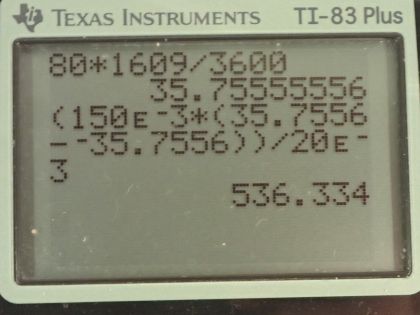Question
A 150-g baseball is initially moving 80 mi/h in the –x-direction. After colliding with a baseball bat for 20 ms, the baseball moves 80 mi/h in the +x-direction. What is the magnitude and direction of the average force exerted by the bat on the baseball?
Final Answer
Solution video
OpenStax College Physics for AP® Courses, Chapter 8, Problem 2 (Test Prep for AP® Courses)

vote with a rating of
votes with an average rating of
.
Calculator Screenshots
Video Transcript
This is College Physics Answers with Shaun Dychko. A 150 gram baseball is initially moving 80 miles per hour in the negative x-direction and then it collides with a baseball bat for 20 milliseconds and then moves 80 miles per hour in the positive x-direction and what is the magnitude and direction of the force exerted by the bat on the ball? So the net force on the ball we are going to ignore gravity here by the way because gravity will be an insignificant force while the baseball bat is in contact with the ball because the bat is going to hit the ball much, much, much harder than the gravity will pull downwards on the ball and we are only given information about its horizontal movement anyway. So this force on the ball due to the bat is the change in momentum of the ball divided by the time during which the force is applied. So that is the final momentum minus initial momentum divided by time which is mass times final velocity minus mass times initial velocity divided by time and then we can factor the mass out and we have m times the difference in velocities divided by time. We have to express these velocities in SI units and so we take negative 80 miles per hour multiplied by 1609 meters per mile times 1 hour for every 3600 seconds and we end up with our answer in meters per second that's negative 35.7556 meters per second and then the final velocity is the positive of the same magnitude. And Δt is 20 times 10 to the minus 3 seconds— writing this in place of the prefix 'milli'— so now we can plug in some numbers. So the force on the ball is 150 grams, written in kilograms as 150 times 10 to the minus 3 kilograms times positive 35.7556 meters per second— final velocity— minus the negative initial velocity divided by 20 times 10 to the minus 3 seconds and that is positive 540 newtons and this positive sign means that the force is in the same direction as the final velocity of the ball.
